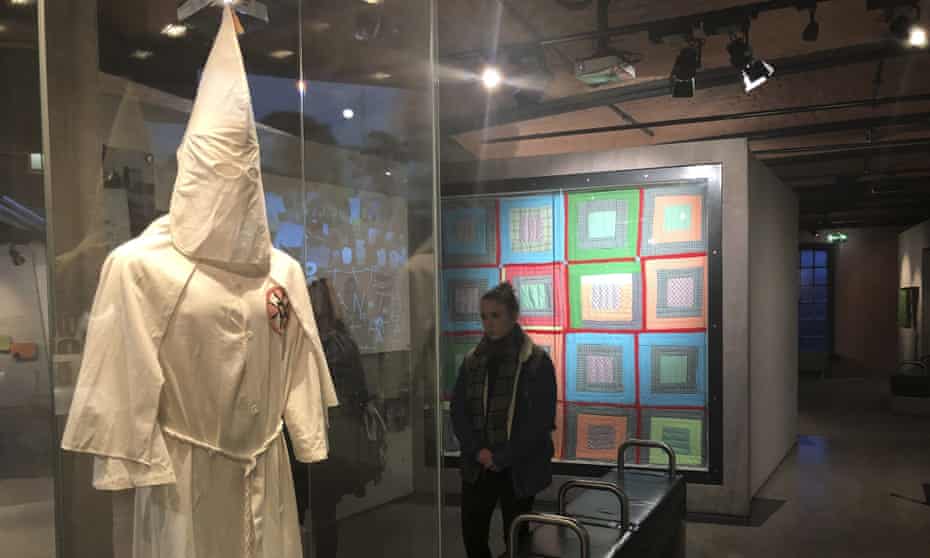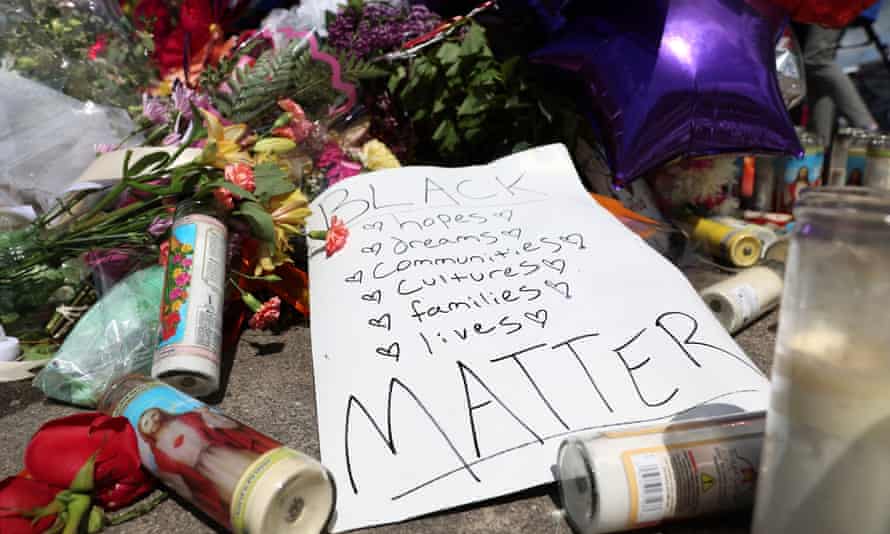A Lynching at Port Jervis review: timely history of New York race hate
In the wake of the Buffalo shooting, Philip Dray’s account of a terrible incident from 1892 seems dreadfully familiar

Visitors at the International Slavery Museum in Liverpool,
England examine a 1920s-era Ku Klux Klan outfit from Port Jervis, New York.
Photograph: Russell Contreras/AP
Michael Henry Adams

Michael Henry Adams
Sun 22 May 2022
Featuring Irish immigrants and the descendants of enslaved Africans in effect set upon each other by the rich, Philip Dray’s A Lynching at Port Jervis covers only 261 pages but is a sprawling book nonetheless.
The Last Slave Ship review: the Clotilda, Africatown and a lasting American injustice
It details the mob murder of Robert Lewis on 2 June 1892, an incident instantly appreciated “as a portent that lynching, then surging uncontrollably below the Mason-Dixon Line, was about to extend its tendrils northward”.
“The name, Port Jervis, the only city in New York where a lynching occurred between 1857 and 1950, became synonymous with intolerance in the north,” Dray writes.
The picturesque town had been seen not as some outpost for southern-style savagery but as a “satellite” of Manhattan, where shrewd sophisticates took the train to shop.
If, as Dray suggests, the outrage at Port Jervis helped spark the anti-lynching crusade of leaders like Ida B Wells or T Thomas Fortune, it failed, and fails still, to occasion anything close to the “reckoning” cited in his subtitle.
With sufficient thoroughness, Dray catalogues lawless executions up to the present. Thanks to technology, he explains, the shameful spectacle of Black Americans being lynched in modern terms, frequently by police officers, is more pervasive than ever. Footage from cellphones and police body or dashboard cameras purveys racist violence nonstop to an audience larger than ever before.
In contrast to the coldblooded massacre in Buffalo, the lynching at Port Jervis seems almost quaint. Certainly its three protagonists – a conflicted May-to-September white couple and a light-skinned, affable African American – acted with a heedlessness that seems almost delusional.
Intelligent, pretty and dark-haired, 23-year-old Lena McMahon was doted on by her adoptive parents. Though she lived at home, running the candy counter at the family store gave her unusual independence.
Philip Foley, a dandified salesman and “rascally lady-killer”, initially met with approval as a suitor. Once Foley was booted out of his hotel for not paying a substantial bill, Miss McMahon’s guardians saw things differently.
Robert Lewis came to know Foley while working at that hotel, the Delaware House. Foley was an obvious sport and generous tipper, a smooth operator who persuaded the impressionable Black man to pinch food and drink from his employer.
Lewis was fired but remained in Foley’s sway. So did Lena McMahon. Defying her parents, ignoring Foley’s insolvency, she became his lover and schemed to run away to New York. How, without even enough cash for a room, did Foley convince her an elopement would work? The befuddlement induced by love and lust almost makes it understandable. But Lewis being induced by Foley to “take” Lena if he wanted her – Foley saying she would resist at first but it would not matter – how did that happen? What Black man then could believe that would not lead to certain death?
With great meticulousness, Dray tells how after the rape, Lewis was apprehended. He was discovered with fishing gear on a “slow-moving coal barge”. He told his captors how McMahon’s white boyfriend, Foley, “urged him to commit the act”.
So it was that following Lewis’s hanging, in which hundreds took part, and after other Black men came forward to say how Foley offered them $5 to sexually assault his lover, Foley was arrested as Lewis’s “accomplice”. Many white people have murdered lovers and then claimed “a Black guy did it”. But how did Foley know he would escape without punishment?
“Judge” William Crane, a revered Port Jervis attorney, is one heroic figure to emerge from the tragedy. He attempted repeatedly to calm the mob and free Lewis. At one point, hoping to gain time, he seized on the idea Lewis might be brought before his victim, McMahon, so she might identify him beyond any doubt.
”Victims” were sometimes allowed to light the pyre to destroy their alleged attackers, and, expanding on this extraordinary custom, Dray shows the considerable scholarship with which he has enriched his story. Especially chilling is his account of one woman, about to set her actual clandestine paramour alight, being rebuked with a final plea: “How, after we have been such sweethearts, can you do this?”
Featuring Irish immigrants and the descendants of enslaved Africans in effect set upon each other by the rich, Philip Dray’s A Lynching at Port Jervis covers only 261 pages but is a sprawling book nonetheless.
The Last Slave Ship review: the Clotilda, Africatown and a lasting American injustice
It details the mob murder of Robert Lewis on 2 June 1892, an incident instantly appreciated “as a portent that lynching, then surging uncontrollably below the Mason-Dixon Line, was about to extend its tendrils northward”.
“The name, Port Jervis, the only city in New York where a lynching occurred between 1857 and 1950, became synonymous with intolerance in the north,” Dray writes.
The picturesque town had been seen not as some outpost for southern-style savagery but as a “satellite” of Manhattan, where shrewd sophisticates took the train to shop.
If, as Dray suggests, the outrage at Port Jervis helped spark the anti-lynching crusade of leaders like Ida B Wells or T Thomas Fortune, it failed, and fails still, to occasion anything close to the “reckoning” cited in his subtitle.
With sufficient thoroughness, Dray catalogues lawless executions up to the present. Thanks to technology, he explains, the shameful spectacle of Black Americans being lynched in modern terms, frequently by police officers, is more pervasive than ever. Footage from cellphones and police body or dashboard cameras purveys racist violence nonstop to an audience larger than ever before.
In contrast to the coldblooded massacre in Buffalo, the lynching at Port Jervis seems almost quaint. Certainly its three protagonists – a conflicted May-to-September white couple and a light-skinned, affable African American – acted with a heedlessness that seems almost delusional.
Intelligent, pretty and dark-haired, 23-year-old Lena McMahon was doted on by her adoptive parents. Though she lived at home, running the candy counter at the family store gave her unusual independence.
Philip Foley, a dandified salesman and “rascally lady-killer”, initially met with approval as a suitor. Once Foley was booted out of his hotel for not paying a substantial bill, Miss McMahon’s guardians saw things differently.
Robert Lewis came to know Foley while working at that hotel, the Delaware House. Foley was an obvious sport and generous tipper, a smooth operator who persuaded the impressionable Black man to pinch food and drink from his employer.
Lewis was fired but remained in Foley’s sway. So did Lena McMahon. Defying her parents, ignoring Foley’s insolvency, she became his lover and schemed to run away to New York. How, without even enough cash for a room, did Foley convince her an elopement would work? The befuddlement induced by love and lust almost makes it understandable. But Lewis being induced by Foley to “take” Lena if he wanted her – Foley saying she would resist at first but it would not matter – how did that happen? What Black man then could believe that would not lead to certain death?
With great meticulousness, Dray tells how after the rape, Lewis was apprehended. He was discovered with fishing gear on a “slow-moving coal barge”. He told his captors how McMahon’s white boyfriend, Foley, “urged him to commit the act”.
So it was that following Lewis’s hanging, in which hundreds took part, and after other Black men came forward to say how Foley offered them $5 to sexually assault his lover, Foley was arrested as Lewis’s “accomplice”. Many white people have murdered lovers and then claimed “a Black guy did it”. But how did Foley know he would escape without punishment?
“Judge” William Crane, a revered Port Jervis attorney, is one heroic figure to emerge from the tragedy. He attempted repeatedly to calm the mob and free Lewis. At one point, hoping to gain time, he seized on the idea Lewis might be brought before his victim, McMahon, so she might identify him beyond any doubt.
”Victims” were sometimes allowed to light the pyre to destroy their alleged attackers, and, expanding on this extraordinary custom, Dray shows the considerable scholarship with which he has enriched his story. Especially chilling is his account of one woman, about to set her actual clandestine paramour alight, being rebuked with a final plea: “How, after we have been such sweethearts, can you do this?”

A memorial, in the wake of a shooting at a Tops supermarket in Buffalo, New York. Photograph: Brendan McDermid/Reuters
If nothing more, the Port Jervis lynching gave rise a classic work of American literature. Stephen Crane, William Crane’s youngest brother, was the author of a penetrating novella, The Monster. Its mythologized Port Jervis is stratified by race, ethnicity and social class.

Paul Auster: ‘It’s distress that generates art’
For enlarging our understanding of America’s enduring enthrallment with the violence, guns and control of white supremacy, A Lynching at Port Jervis is superlative.
A 1900 “race riot” and near-lynching of an African American in Akron, Ohio, comes to mind. Louis Peck was held for supposedly attacking a young girl. When it was discovered he had been spirited away to Cleveland, rioters dynamited the stone jail and burned down a municipal building. Peck was tried and convicted in 20 minutes. In 1913, he was found to have been wrongfully imprisoned, and released.
The rise of the Ku Klux Klan in the north during the boom times of the 1920s is also instructive today. So is the subsequent rise of the John Birch Society and a proliferation of riotous rebellions during the civil rights era.
Am I wrong to find Dray’s account of such developments unsatisfying, for its lack of answers? Perhaps there is no answer to race hate, except for the one prescribed by A Lynching at Port Jervis. Investigate, reflect and resolve.
A Lynching at Port Jervis: Race and Reckoning in the Gilded Age is published in the US by Farrar, Straus & Giroux
If nothing more, the Port Jervis lynching gave rise a classic work of American literature. Stephen Crane, William Crane’s youngest brother, was the author of a penetrating novella, The Monster. Its mythologized Port Jervis is stratified by race, ethnicity and social class.

Paul Auster: ‘It’s distress that generates art’
For enlarging our understanding of America’s enduring enthrallment with the violence, guns and control of white supremacy, A Lynching at Port Jervis is superlative.
A 1900 “race riot” and near-lynching of an African American in Akron, Ohio, comes to mind. Louis Peck was held for supposedly attacking a young girl. When it was discovered he had been spirited away to Cleveland, rioters dynamited the stone jail and burned down a municipal building. Peck was tried and convicted in 20 minutes. In 1913, he was found to have been wrongfully imprisoned, and released.
The rise of the Ku Klux Klan in the north during the boom times of the 1920s is also instructive today. So is the subsequent rise of the John Birch Society and a proliferation of riotous rebellions during the civil rights era.
Am I wrong to find Dray’s account of such developments unsatisfying, for its lack of answers? Perhaps there is no answer to race hate, except for the one prescribed by A Lynching at Port Jervis. Investigate, reflect and resolve.
A Lynching at Port Jervis: Race and Reckoning in the Gilded Age is published in the US by Farrar, Straus & Giroux
No comments:
Post a Comment